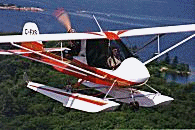|
Home Page | Order Challenger Video | Be Notified Of Web Site Updates | Contact Us This section answers the questions we are most frequently asked about the Challenger. All our answers, and even the questions themselves, are based specifically on the aviation environment in Canada. Elsewhere, particularly in the United States, air regulations and other aspects are completely different! Questions and answers are organized into logical groupings. For the reader's convenience, some questions and answers appear in more than one group. There are thousands of words in this section - we strongly suggest you don't try to read them all! Check out the overviews and review the lists of questions in each grouping. To avoid scrolling through all the answers, when you see a question relevant to your specific situation, simply click on it to be transported to your answer. Use the browser's Back button to return to the questions list.
FREQUENTLY ASKED QUESTIONS Why do some people equate the term "ultralight"
with risk and wreckage? A surprising number of people are still under the impression that ultralights are dangerous - mere lawnchairs with wings and chainsaw motors. These preconceived notions date back to the unregulated late seventies and early eighties when ultralights were powered hang gliders flown by unlicensed, untrained pilots. In those days this segment of aviation WAS dangerous! In 1983 Canada legislated that ultralight aircraft be registered and that ultralight pilots be trained and licensed. Also in 1983, a new generation of ultralights emerged, the Challenger being a leading example. Ultralights in this class look and handle like real airplanes and can fly long distances in real weather. A study was made of all aviation accidents in Canada from 1987 to 1996, a ten year period after the bad old days were history. This revealed that ultralights actually have fewer accidents than general aviation aircraft such as Cessnas, a reflection of ultralights being much more docile and easier to fly. As well, the study showed that if an accident does occur it is much less likely to be fatal in an ultralight, a result of the much lower speeds involved. Here's the link: UPAC Study Of Aircraft Accidents In Canada From 1987 To 1996 The Challenger has an excellent safety record, second to no other airplane. With over 4,000 shipped since 1983, some having accumulated thousands of flight hours, any design or manufacturing defects would long since have been discovered and remedied. In fact, there have been zero structural failures on properly assembled Challengers flown within their stipulated speed ranges. The biggest single cause of all aviation accidents, some say the vast majority, is the pilot. It is not the plane that decides to continue into thunderstorms, run out of gas over a forest or put on an impromptu airshow to impress onlookers. Challenger owners range from folks who'd never flown before acquiring their Challenger to aviation professionals with many years in the airlines or military. These people chose the Challenger because it is proven to minimize the small percent of the risk related to the airplane. They manage the pilot induced portion of the risk by training diligently and by making conservative decisions. The great thing about aviation is that you yourself get to manage virtually all of the risk factors. There are far fewer random elements in the air than there are on the public roads. Your airplane is not going to be T-boned by a drunk running a red light! Flying is as safe or as dangerous as YOU choose to make it. Do ultralights need to be registered? Do I
need a pilot licence to fly one? These are far and away the most frequently asked questions about the regs. In Canada all aircraft must be registered and all pilots must be licensed. Passenger carrying and other privileges and restrictions depend upon the pilot's licence and how the individual plane is registered, not just its type. New Challengers can be registered as Advanced Ultralights. Used Challengers registered as Basic can not be upgraded to Advanced. Passengers may only be carried in Advanced Ultralights, regardless of the licence held by the pilot. For a quick overview of the Canadian scene click to Regulations In A Nutshell. For the full details plus lots of other questions and answers click to our three FAQ's on Aircraft Registration, Pilot Licensing, and Operating Rules. For a table comparing the privileges, requirements and costs of the Ultralight, Recreational and Private licences click to Canadian Licence Comparison. The Light Sport Aircraft category and the Sport Pilot Permit came out in the United States in 2004. They are much like our Canadian Advanced Ultralight category and Ultralight Pilot Permit with Passenger Carrying Endorsement. I already have a licence - how long will a
Challenger checkout take? These are typical of the questions we get asked about checkouts and ab initio training. They generally revolve around the notion of minimizing time, energy and money to be invested in training, without of course compromising safety. For the wannabe pilot the answers generally suggest training in your own Challenger. This is not just the most cost efficient approach by far, but it also produces pilots with the highest possible level of proficiency in normal and emergency handling specific to the aircraft they will own and operate. For the detail answers to these and other questions click to Pilot Training. For a comparison of the privileges, requirements and costs of the Ultralight, Recreational and Private licences click to Canadian Licence Comparison. If you wish, we'll notify you automatically by e-mail when this site is updated!
To learn and see more order our comprehensive information package and video! |

